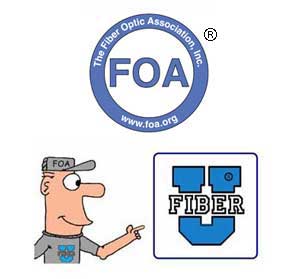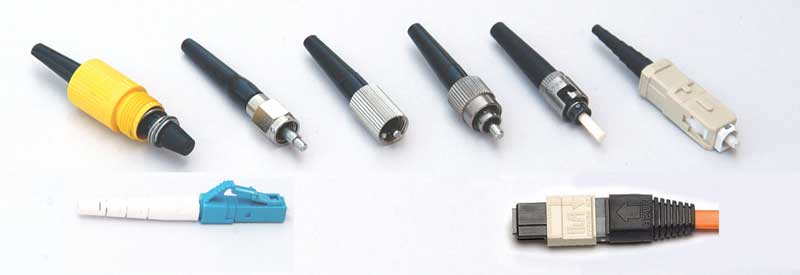Fiber
Optic Connector Identification MiniCourse
Fiber
U MiniCourses are courses on a specific topic that you can
take in about an hour or less. They are based on questions
people ask FOA all the time, so the topics are recommended
by our readers.
Level: Basic
Intended For:
Designers
of fiber optic communications networks
Users
of fiber optic communications networks
Contractors and techs who install, operate and maintain
them.
Objectives:
From this self-study program you should learn:
How
to identify the most common fiber optic connectors in
use today
How
to identify older connectors that may still be in use in
some systems
Some
history of the development of fiber optic connectors
- Prerequisites

When
you finish, you can take an online test on this course to
qualify for a "Fiber U Certificate of Completion." The
test cost for a Fiber U MiniCourse is $10US.
Introduction
The development of fiber optic connectors
was equally important to the growth of fiber optic
applications as was the development of fiber, cable,
lasers, etc. The first fiber optic connectors were
developed in the mid to late 1970s for the first multimode
fibers. When singlemode fiber began to become available in
the early-mid 1980s, the connector became a critical
component needed to precisely align the extremely small
cores of singlemode fibers. Early connectors like the SMA
and Biconic were replaced by FC, ST and D4
connectors that could provide the greater
precision demanded by singlemode fibers. In the late
1990s, a new generation of smaller connectors were needed
for higher density patch panels and smaller transceiver
modules. The pursuit of smaller, higher density connectors
continues to this day.
Over the history of fiber optics, more than 100 connector
designs have been developed, but only a few gained
widespread use. This course will focus on the popular
connectors today, then look at some of the other designs
and help the user learn how to identify connectors,
especially some older ones, when they encounter them in
their work.
Assignments
For
this lesson plan you will be instructed to watch the
videos, read
the references
and take a quiz (Test Your Knowledge) to complete the
course.
Lesson
Plans
Watch
the videos, read the section in the FOA Guide and take
the quiz. For this course, we recommend watching the
videos first and then reading the FOA Guide page on
Restoration. There is a short quiz you can use to check
your comprehension. The Certificate of Completion test
is based on those materials.
Videos
FOA
Lecture 54 Fiber Optic Connector Identification.
FOA Guide
Fiber
Optic Connector Identifier.
Connector
Names And Terminilogy.
Additional reading:
Test Your Comprehension
Fiber Optic
Connector Identification Quiz.

When
you finish all the assignments you can take an online test
on this course to qualify for a "Fiber U Certificate of
Completion." The test cost is $10US.
Go here to take the Fiber
U Connector Identification Certificate of
Completion test. Here
are detail directions if this is your first time
taking a Fiber
U Certificate of Completion exam.
This information is
provided by The Fiber Optic Association, Inc. as a
benefit to those interested in teaching, designing,
manufacturing, selling, installing or using fiber optic
communications systems or networks. It is intended to be
used as an overview and/or basic guidelines and in no
way should be considered to be complete or
comprehensive. These guidelines are strictly the opinion
of the FOA and the reader is expected to use them as a
basis for learning, as a reference and for creating
their own documentation, project specifications, etc.
Those working with fiber optics in the classroom,
laboratory or field should follow all safety rules
carefully. The FOA assumes no liability for the use of
any of this material.
|



